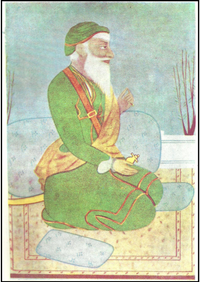Diwan Mokham Chand (died 16 or 29 October 1814) was one of the chief commanders of the Sikh Empire. He conquered Attock from the Durrani Afghans in 1813 and subdued the Rajputs in the Hills of Himachal and in Jammu at Jasrota, Chamba, and Basroli. He also commanded one of the early Sikh expeditions to conquer Kashmir that ended in failure due to bad weather blocking the passes to the valley. Mokham Chand was born in a Hindu Khatri family.
|
Diwan
Mokham Chand
|
|
|---|---|
 |
|
| Born | 1750 |
| Died | 16 or 19 October 1814 Phillaur, Sikh Empire |
| Rank | Military officer |
| Children | Diwan Moti Ram |
Early life
Mokham Chand was born in a Hindu Khatri family of a Kochhar background, to Vaisakhi Mal, a tradesman of the village Kunjah near Gujrat.
Before taking up work under Ranjit Singh, he had worked under Dal Singh Gill of Akalgarh as a munshi (accountant) until 1804 when Dal Singh would die. After Dal Singh Gill’s passing, his widow, Sehju, did not get along with Mokham Chand and therefore the latter sought employment elsewhere.
His next stint was with Sahib Singh Bhangi of Gujrat between 1804–1806, where he was appointed to the position of diwan. He eventually fell out of favour and was even imprisoned awaiting execution but the wife of Sahib Singh, Chand Kaur, spared his life by assisting his escape.
He would find work under Maharaja Ranjit Singh in 1806 after his escape from the Bhangis.
Military career

Mokham Chand was one of the most distinguished general of Ranjit Singh. He helped with many conquests between the years 1806–1814.
Ranjit Singh had seen him in action at Akalgarh three years earlier and again in the fight against the Bhangi Sardar of Gujrat. Mokham Chand had fallen out with the Bhangi and came to Ranjit Singh upon his request. Ranjit welcomed him with handsome gifts of an elephant and horses and granted him the Dallewalia possessions as a Jagir. He was made commander of a cavalry unit with the power to recruit 1500 foot soldiers as well.
In the beginning of 1808 various places in the Upper Punjab were taken from their independent Sikh proprietors, and brought under the direct management of the new kingdom of Lahore, and Mokham Chand was at the same time employed in effecting a settlement of the territories which had been seized on the left bank of the Sutlej. But Ranjit Singh’s systematic aggression had begun to excite fear in the minds of the Sikhs of Sirhind
In September 1808, he was responsible for receiving the British East India Company envoy Charles Metcalf at Kasur alongside Fateh Singh Ahluwalia, for the former’s visit to Lahore. Remarks about the martial prowess of the British and Sikhs were exchanged between the two.
Historians report an interesting conversation between Charles Metcalf and Mohkam Chand: the latter commented that the British had not seen Sikh bravery on the battlefield, to which Metcalf readily responded that the Sikh had not yet seen British courage.
— Robina Yasmin, Muslims Under Sikh Rule in the Nineteenth Century: Maharaja Ranjit Singh and Religious Tolerance, page 93
In the year 1812, he was awarded with the titles of diwan and fateh nasib.
He was the commander in chief of armies in Battle of Attock which defeated Durrani Empire Wazir Fateh Khan and Dost Mohammad Khan. With the permission of the Maharaja, the Sikh forces attacked the Afghans on 12 July, 1813 at Hazro, about 8 kilometers from Attock. This battle is also known as the battle of Chhuchh. Terrible fighting took place between the adversaries. In the meantime, Afghans received fresh reinforcements under Dost Muhammad Khan. The Diwan left his elephant, mounted a horse and personally leading his reserves fell upon the disorganized Afghans. Hand to hand fighting took place and there were heavy losses on both sides. Diwan Amar Nath mentions that 2,000 Afghans were killed. Dost Muhammad was seriously wounded. Many Afghans drowned in the Indus and a large number were taken prisoner. The Sikhs plundered the provisions of the Afghans. Besides Diwan Mohkam Chand, Jodh Singh Kalsia and Fateh Singh Ahluwalia, Sardar Dal Singh, Diwan Ram Dayal also took part in fighting against Afghans at Hazro. Fateh Khan fled away to Peshawar. Thus the victory for the Sikhs was complete. The credit for this major triumph goes to the dynamic generalship of Diwan Mohkam Chand. Hukam Singh Chimni was appointed Qiladar of the fort of Attock.
Death and successors
Diwan Mokhham Chand Nayyar died at Phillaur on 29 October 1814, on a Saturday. His son Diwan Moti Ram and grandsons Diwan Kirpa Ram and Diwan Ram Dayal succeeded him as Governors of Attock.
He was one of the architects of the Sikh empire who rose by dint of merit to the post of Diwan and virtually the commander-in-chief of the Sikh forces. N. K. Sinha observes. “As a general, he was uniformly successful and from 1806 to 1814 the annexation of Ranjit Singh was due not only to his irresistible cunning but also to Mohkam Chand’s military talents.” Ranjit Singh always held him in high esteem. He had a sound knowledge of military tactics and strategy. He did not suffer a defeat; he was an ever victorious General.
